How to Build Food Delivery Apps Like Uber Eats

IT copywriter
Reading time: 16 min
In the digital age we are living in, people are getting used to buying everything online — including groceries. Before 2020, the food-related eCommerce businesses were considered a niche segment but, ever since 2019, the delivery services expanded immensely, especially in the United States, adding billions of dollars to the market shares.
Platform-to-customer delivery services like Uber Eats, Deliveroo and DoorDash experienced tremendous rises in orders between February and March, when the government advised people to stay at home. The industry suddenly teleported a few years into the future. Instacart’s delivery service met their 2022 goals in the first three weeks of lockdown and Uber Eats increased their profit up to 152% in 2020.
If you ever considered stepping into the world of meal delivery, now is the best time. This article will serve as a guide to how to launch a food delivery app like Uber Eats.
Reasons for the Boom of Food Delivery Apps
People are always finding new ways to make their life easier and delivery services are ready to relieve them from two mundane tasks: cooking and shopping for food. The grocery delivery industry is growing by the day. Everything can be delivered right to your doorstep, from takeout meals in your favorite restaurant to fast food and shopping carts full of vegetables from the local grocery stores.
There are a few reasons why delivery-centered businesses have gained so much momentum lately:
- The pandemic. The recent spike in demand for the food industry delivering services is mostly due to the lockdowns, when people were advised to stay home. With food being the vital element of human life, a bunch of new customers flooded online grocery shops.
- Convenience. Food can be ordered in a few taps on the mobile app and it will be delivered to the customer’s doorstep in an hour or less.
- Service variety. More and more restaurants are either developing their own delivery services or joining the shared delivery services like Postmates, GrubHub, Deliveroo and Glovo. Popular food chains like Burger King consider delivery to be a must-have feature.
The reasonable question is — what will happen after the pandemic ends? Will the delivery services be forgotten and turn into a niche segment once again? The answer is an emphatic no. Currently, 60% of Americans order food online once a week but, before the pandemic, a lot of people never even considered ordering food online. However, now they got a taste of its convenience and the variety available, they will be more likely to continue ordering in the future. Therefore, the lockdowns may end, but the trend is expected to continue.
The UberEats Business Model
Prior to the pandemic, Uber was a major player in the transportation industry, with their Uber drivers reshaping the taxi service. UberEats was founded long ago in 2014, connecting restaurants with customers. The business was going well, but steady before finally soaring above most market leaders in 2020.
So, what is the model that delivery services like UberEats use? Participating in the model, there are three groups of users:
- Restaurant workers. To start working within the delivery app, a restaurant should register in a system, write a description, pinpoint the location and load the menu items. After the procedure is completed, they receive orders from clients. Restaurants maintain their accounts themselves, updating menus and adding discounts and promotions.
- Customers. Inside the app, the client will register, browse restaurants and add meals to the cart, paying and ordering online. The orders can be placed in real-time or be customized with a delivery date, time and place.
- Delivery workers. They get notifications about available delivery requests in their range, pick ones they want and take them to the customer.
Apps handle more than that. They secure transactions, estimate delivery times and can even track your order on the map – they execute a lot of processes, ultimately satisfying all three groups.
UberEats charges both customers and restaurants with each order.
Aside from paying for the meal and local taxes, per each order, the customer pays a delivery and service fee. The delivery fee is calculated according to the restaurant proximity — the further the place, the more the fee. The service fee is usually fixed to a percentage of an order. It’s not mandatory, but the customer can also add a small tip for the delivery person.
To get rid of the delivery fee and reduce the service fee to 5%, customers may participate in UberEats’ $9.99 subscription fee.
 The restaurants also pay two fees — a one-time activation fee and percentages from each order. They are a bit high, but for a lot of local restaurants and small businesses, it would still be more expensive to develop their own apps, so they agree on these terms. Some restaurants place higher prices in delivery apps to avoid income loss.
The restaurants also pay two fees — a one-time activation fee and percentages from each order. They are a bit high, but for a lot of local restaurants and small businesses, it would still be more expensive to develop their own apps, so they agree on these terms. Some restaurants place higher prices in delivery apps to avoid income loss.
The advertisement fee is optional for the restaurants willing to pay to appear in top searches.
The delivery workers get paid for successfully completed orders. The process behind UberEats’ algorithm involving the pay rate calculations is not in open access, but it is most likely composed of base fare, tips and trip supplement. The old UberEats LA model goes like this:
Developing a Food Delivery App Like Uber Eats in 5 steps
Wrestling a newly crowned delivery giant like UberEats would not be easy, but it is still possible to bite into the market and succeed. We’ve put our experience with app development into crafting a five-step guide. It’s useful for everyone who is considering creating their own food delivery service.
Step #1. Conduct Food Delivery Market Research
Start with research. Thorough market analysis will give you an understanding of the market state, trends, competition and help you define the audience your app will be aimed at.
- Competitors. Look into what made others succeed: what are their strategies, what services do they provide, and how do they handle their businesses? Try to find weaknesses you can learn from and avoid.
- Target audience. Who are the people you’d like to serve and get income from? Millennials tend to order online more than buy on premise, but middle-aged people can afford to buy more. Age, region, social class — be thorough in defining your client’s profile.
- Trends. What is popular on the market? Why do people use one app instead of another? Which delivery channels bring more customers? Find out what’s trending and implement it in your app.
- Functionality. While bare functionality is similar among all delivery apps, some unique features may attract certain customers to your delivery app.
Step #2. Choose Food Delivery Model
There are two business models for you to choose from:
- Order-only model — the app collects and distributes orders from customers to restaurants. After the order is handed over, the delivery becomes the responsibility of the restaurant’s own workers.
- Order and delivery model — the platform collects orders, distributes them from the customers to the restaurants and sends the platform’s workers to pick up the order and deliver it to the customer.
The second model is obviously more complex and requires more resources, but it pays more in the end. Let’s compare these business models:
Step #3. Choose Best Features of Uber Eats Like Apps
There are many Uber Eats clones on the market, so it’s important to stand out. While searching for unique features, don’t forget about vital functionality for the following:
The core functionality is serving the three-way connection between restaurants, customers and delivery workers, with managerial headquarters supporting this connection.
Step #4. Choosing the Right Technology Stack
In building an app, make sure to choose technologies properly, as they will be the foundation of its usability, performance and form user experience. Some technologies can be borrowed from third-party services because you won’t have the resources or time to spend on developing your own payment or tracking service.
Payment Gateway Services
Payment gateways serve to accept online payments from clients’ cards. They secure a connection between the respected bank and your mobile application. The payment gateways come in three types:
- Hosted — the getaway brings your customers from your app to the payment gateway page. The payment happens here and the customer is redirected to your app.
- Self-hosted — the app collects the required data and the payment processing happens off-screen in the backend.
- Non-hosted — the app collects and processes the payments by itself.
For food-delivery apps, the most applicable payment gateways are hosted or self-hosted as they are using third-parties. Examples of such getaways are: Paypal, Square and Stripe.
Location Services
These services will help you with real-time order tracking on the map. They will also help to estimate the delivery time based on algorithms and mileage, locate restaurants in the clients’ vicinity and provide routes for delivery workers. Most of them use satellite signals and provide more or less precise information on tracked object whereabouts. One of the best location services in the business is Google maps.
Cloud Services
Delivery apps attract large clientele and work with great amounts of data, from restaurant profiles to big data about clients’ preferences. Your business must be ready to scale to spikes in activity. Cloud services are useful tool to solve these problems by enhancing reaction speed as well as providing a stable and scalable environment. The examples of cloud platforms for delivery apps are Amazon and Azure Cloud services.
Push Notification Services
Push notifications are sending information from the app even when it isn’t active. They’re vital for eCommerce as they acquire client attention with promotions and remind them to open the application. For delivery apps, they are also required to send orders to restaurants and delivery workers, and notify the customers of their order status. To build push notifications, you can use Firebase Cloud messaging.
Live Chat Services
Chat services are necessary for customer and restaurant tech support, as well as conversations between headquarters, restaurants and delivery workers. They can also convert lingering visitors into paying customers by engaging with them in the app. Live chat must support high workloads . You can use LiveChat or MobileMonkey to implement live chat into your app.
SMS and Mailing Services
These services will come in handy in confirming the user’s identity — send a confirmation code to customers to avoid the misuse of personal information. These messages should be arriving to the customer in 2-5 minutes, otherwise you may lose them. You can use Twilio or Vonage in your app for SMS and MailChimp or Sendinblue for mailing services.
Step #5. Hire an App Development Team
Selecting a development company is a very important step in app creation. A professional development team can build an app that matches your vision for the project and suggest optimal implementation routes.
Consider hiring app development team members using the following list as needed:
- Android and/or iOS developers — to build your application on one or multiple platforms;
- Back-end developer — to construct server-side application logic and integrate front-end developers’ work into the app;
- Project Manager — to organise the work of all team members;
- Business Analyst — to conduct market research and act as a bridge between IT and the business side.
- UI/UX designer — to create a unique, user-friendly interface;
- Testing engineers — to make sure your application works well and remove all bugs before project launches.
Must-Do Things on a Post-Production Stage
Now that your app is up and ready, it’s time to enter the post-production stage. Here’s the list of essential steps to take after app development.
Collect and analyze feedback
Your customers can give you some valuable insights. They’re the ones your product is aimed at, so make sure to learn from user experience and improve your app by considering users’ preferences and complaints. Provide polls for customers and collect data from technical support chats.
Attract more clients
Introduce special promotions to encourage users to install your application. Increase user acquisition by offering discounts and bonus points on installation and first orders, propose to partnered restaurants to participate in advertisement by inviting their customer base to your app through their own promotions.
Find investors
Fundraising is important to keep your app growing and attract more restaurants and customers. In scaling your business, you will need investors, so consider researching and finding external funds from those who may be interested in your business.
Monetize your application
There are many ways to ensure your application will bring profits. At the start, you can charge the service fees, delivery fees and order fees, but as your application grows, you may implement several other profit channels like charging an advertisement fee, providing premium accounts, first-row delivery options and subscriptions services.
How much does it cost to build an app like UberEats?
The final development cost for an application depends on many factors: choosing an Android or iOS platform (or both), cloud provider selection, the app’s functionality, the cost of the app developers, and the scale of the overall project.
The cost can be estimated by considering software development stages by evaluating how many paid hours you expect for each step.
Wrapping Up
While food delivery application development is a road full of hardships, the result is well worth the effort. If you are considering creating an app like UberEats, contact us and we will gladly estimate the development cost for you.
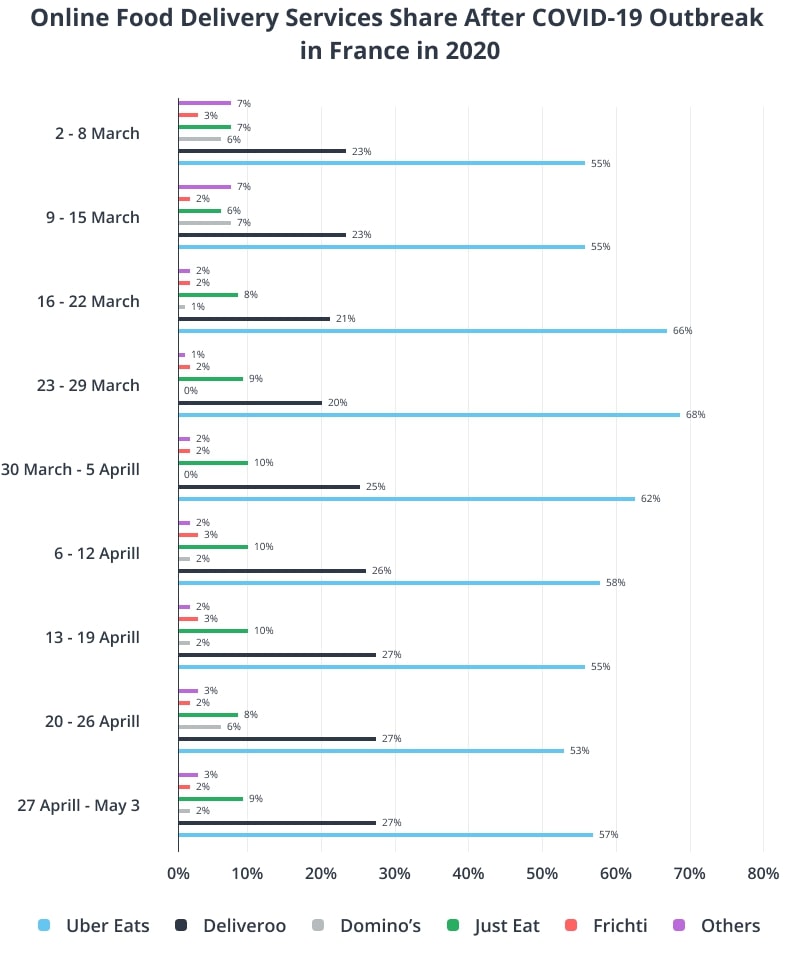
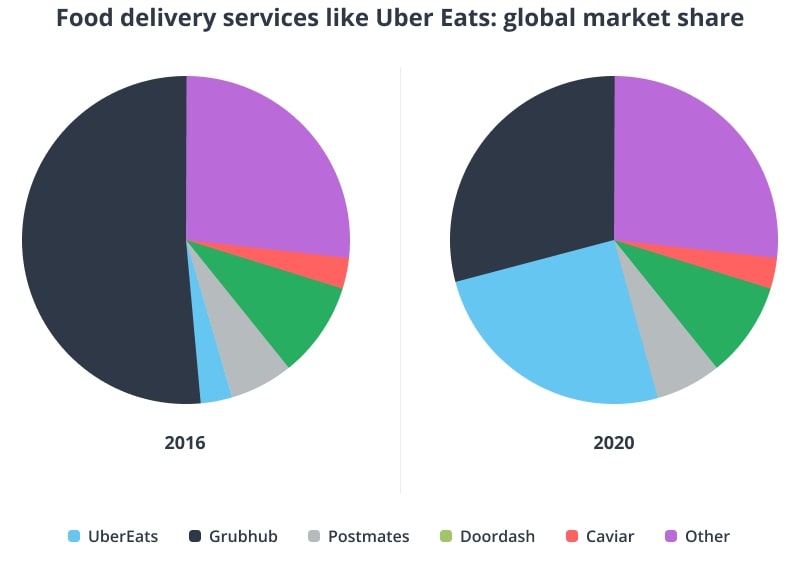
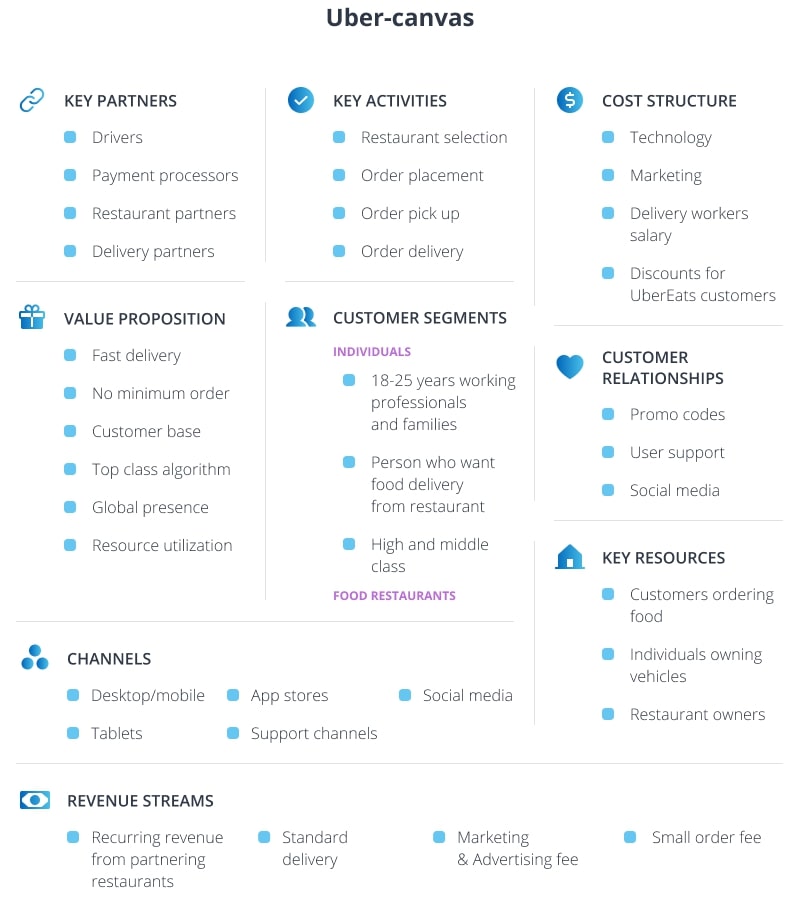


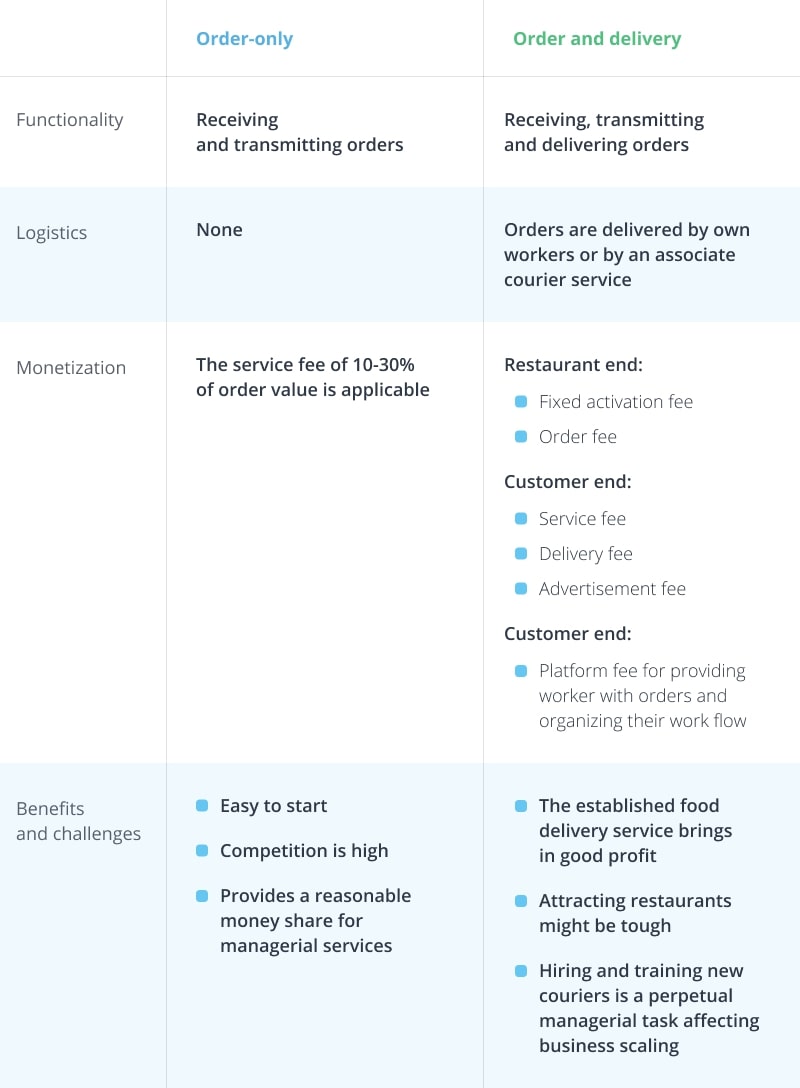
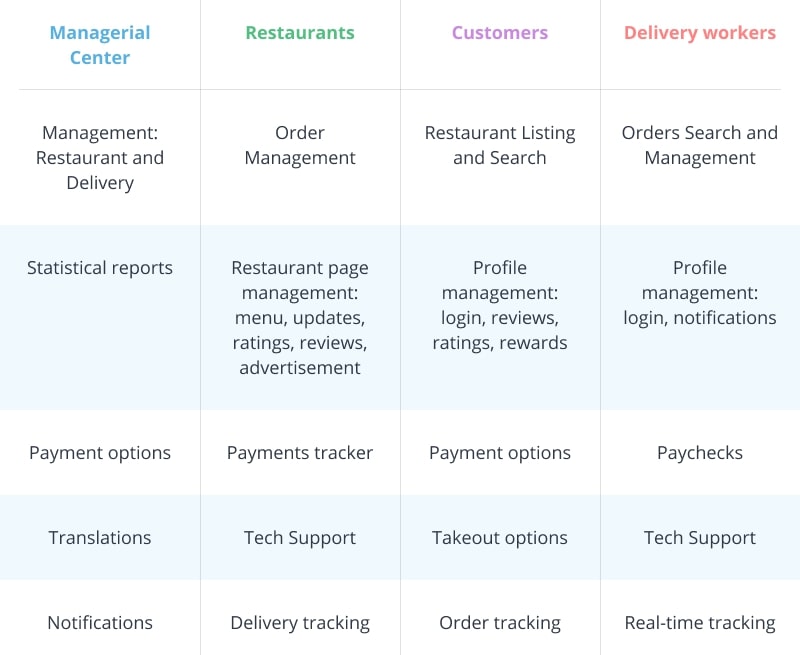
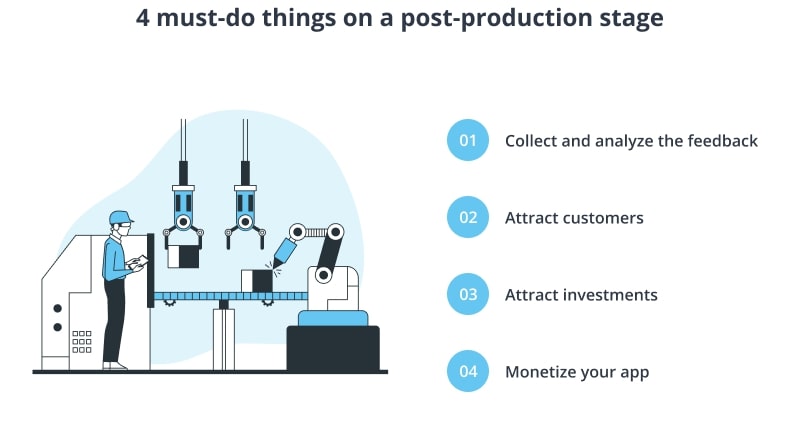


Comments